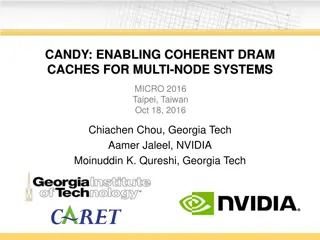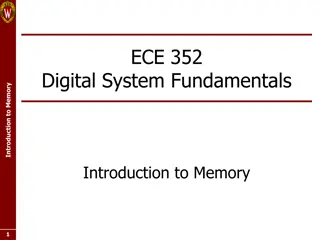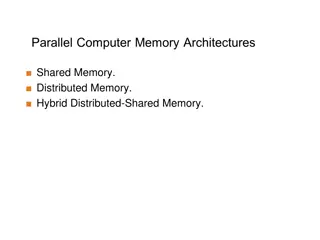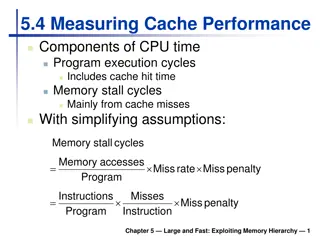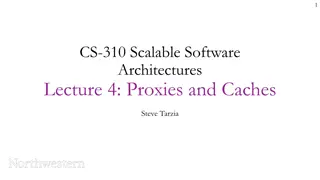Memory and Caches in CSE 351 Spring 2020: Insights and Roadmap
Exploring the world of memory and caches in CSE 351 Spring 2020 led by Instructor Ruth Anderson and her dedicated team of Teaching Assistants. Discover the essential topics covered such as data integers, x86 assembly, processes, and more. Dive into the nuances of memory allocation, Java implementation, and learn how execution time varies with data size. Uncover mnemonic aids and insights shared for effective learning and retention.
Download Presentation

Please find below an Image/Link to download the presentation.
The content on the website is provided AS IS for your information and personal use only. It may not be sold, licensed, or shared on other websites without obtaining consent from the author.If you encounter any issues during the download, it is possible that the publisher has removed the file from their server.
You are allowed to download the files provided on this website for personal or commercial use, subject to the condition that they are used lawfully. All files are the property of their respective owners.
The content on the website is provided AS IS for your information and personal use only. It may not be sold, licensed, or shared on other websites without obtaining consent from the author.
E N D
Presentation Transcript
L16: Caches I CSE351, Spring 2020 Memory & Caches I CSE 351 Spring 2020 Instructor: Ruth Anderson Teaching Assistants: Alex Olshanskyy Rehaan Bhimani Callum Walker Chin Yeoh Diya Joy Eric Fan Edan Sneh Jonathan Chen Jeffery Tian Millicent Li Melissa Birchfield Porter Jones Joseph Schafer Connie Wang Eddy (Tianyi) Zhou Alt text: I looked at some of the data dumps from vulnerable sites, and it was ... bad. I saw emails, passwords, password hints. SSL keys and session cookies. Important servers brimming with visitor IPs. Attack ships on fire off the shoulder of Orion, c-beams glittering in the dark near the Tannh user Gate. I should probably patch OpenSSL. http://xkcd.com/1353/
L16: Caches I CSE351, Spring 2020 Administrivia Unit Summary #2 due Friday (5/08) Lab 3 due Wednesday (5/13) You must log on with your @uw google account to access!! Google doc for 11:30 Lecture: https://tinyurl.com/351-05-04A Google doc for 2:30 Lecture: https://tinyurl.com/351-05-04B 2
L16: Caches I CSE351, Spring 2020 Roadmap C: Memory & data Integers & floats x86 assembly Procedures & stacks Executables Arrays & structs Memory & caches Processes Virtual memory Memory allocation Java vs. C Java: Car c = new Car(); c.setMiles(100); c.setGals(17); float mpg = c.getMPG(); car *c = malloc(sizeof(car)); c->miles = 100; c->gals = 17; float mpg = get_mpg(c); free(c); Assembly language: get_mpg: pushq %rbp movq %rsp, %rbp ... popq %rbp ret OS: Machine code: 0111010000011000 100011010000010000000010 1000100111000010 110000011111101000011111 Computer system: 3
L16: Caches I CSE351, Spring 2020 Aside: Units and Prefixes Here focusing on large numbers (exponents > 0) Note that 103 210 SI prefixes are ambiguous if base 10 or 2 IEC prefixes are unambiguously base 2 4
L16: Caches I CSE351, Spring 2020 How to Remember? Will be given to you on Final reference sheet Mnemonics There unfortunately isn t one well-accepted mnemonic But that shouldn t stop you from trying to come with one! Killer Mechanical Giraffe Teaches Pet, Extinct Zebra to Yodel Kirby Missed Ganondorf Terribly, Potentially Exterminating Zelda and Yoshi xkcd: Karl Marx Gave The Proletariat Eleven Zeppelins, Yo https://xkcd.com/992/ Post your best on Piazza! 5
L16: Caches I CSE351, Spring 2020 How does execution time grow with SIZE? int array[SIZE]; int sum = 0; for (int i = 0; i < 200000; i++) { for (int j = 0; j < SIZE; j++) { sum += array[j]; } } Execution Time Plot: SIZE 6
L16: Caches I CSE351, Spring 2020 Actual Data 45 40 35 30 Time 25 20 15 10 5 0 0 2000 4000 6000 8000 10000 SIZE 7
L16: Caches I CSE351, Spring 2020 Making memory accesses fast! Cache basics Principle of locality Memory hierarchies Cache organization Program optimizations that consider caches 8
L16: Caches I CSE351, Spring 2020 Processor-Memory Gap Moore s Law Proc 55%/year (2X/1.5yr) Processor-Memory Performance Gap (grows 50%/year) DRAM 7%/year (2X/10yrs) 1989 first Intel CPU with cache on chip 1998 Pentium III has two cache levels on chip 9
L16: Caches I CSE351, Spring 2020 Problem: Processor-Memory Bottleneck Processor performance doubled about every 18 months Bus latency / bandwidth evolved much slower Main Memory CPU Reg Core 2 Duo: Can process at least 256 Bytes/cycle Core 2 Duo: Bandwidth 2 Bytes/cycle Latency 100-200 cycles (30-60ns) Problem: lots of waiting on memory cycle: single machine step (fixed-time) 10
L16: Caches I CSE351, Spring 2020 Problem: Processor-Memory Bottleneck Processor performance doubled about every 18 months Bus latency / bandwidth evolved much slower Main Memory CPU Reg Cache Core 2 Duo: Can process at least 256 Bytes/cycle Core 2 Duo: Bandwidth 2 Bytes/cycle Latency 100-200 cycles (30-60ns) Solution: caches cycle: single machine step (fixed-time) 11
L16: Caches I CSE351, Spring 2020 Cache Pronunciation: cash We abbreviate this as $ English: A hidden storage space for provisions, weapons, and/or treasures Computer: Memory with short access time used for the storage of frequently or recently used instructions (i-cache/I$) or data (d-cache/D$) More generally: Used to optimize data transfers between any system elements with different characteristics (network interface cache, I/O cache, etc.) 12
L16: Caches I CSE351, Spring 2020 General Cache Mechanics Smaller, faster, more expensive memory Caches a subset of the blocks Cache 7 9 14 3 Data is copied in block-sized transfer units Memory Larger, slower, cheaper memory. Viewed as partitioned into blocks 0 1 2 3 4 5 6 7 8 9 10 11 12 13 14 15 13
L16: Caches I CSE351, Spring 2020 General Cache Concepts: Hit Data in block b is needed Request: 14 Block b is in cache: Hit! Cache 7 9 14 14 3 Data is returned to CPU Memory 0 1 2 3 4 5 6 7 8 9 10 11 12 13 14 15 14
L16: Caches I CSE351, Spring 2020 General Cache Concepts: Miss Data in block b is needed Request: 12 Block b is not in cache: Miss! Cache 7 9 12 14 3 Block b is fetched from memory Request: 12 12 Block b is stored in cache Placement policy: determines where b goes Replacement policy: determines which block gets evicted (victim) Memory 0 1 2 3 4 5 6 7 8 9 10 11 12 12 13 14 15 Data is returned to CPU 15
L16: Caches I CSE351, Spring 2020 Why Caches Work Locality: Programs tend to use data and instructions with addresses near or equal to those they have used recently 16
L16: Caches I CSE351, Spring 2020 Why Caches Work Locality: Programs tend to use data and instructions with addresses near or equal to those they have used recently block Temporal locality: Recently referenced items are likely to be referenced again in the near future 17
L16: Caches I CSE351, Spring 2020 Why Caches Work Locality: Programs tend to use data and instructions with addresses near or equal to those they have used recently block Temporal locality: Recently referenced items are likely to be referenced again in the near future Spatial locality: Items with nearby addresses tend to be referenced close together in time block How do caches take advantage of this? 18
L16: Caches I CSE351, Spring 2020 Example: Any Locality? sum = 0; for (i = 0; i < n; i++) { sum += a[i]; } return sum; Data: Temporal: Spatial: sum referenced in each iteration consecutive elements of array a[]accessed Instructions: Temporal: Spatial: cycle through loop repeatedly reference instructions in sequence 19
L16: Caches I CSE351, Spring 2020 Locality Example #1 int sum_array_rows(int a[M][N]) { int i, j, sum = 0; for (i = 0; i < M; i++) for (j = 0; j < N; j++) sum += a[i][j]; return sum; } 20
L16: Caches I CSE351, Spring 2020 Locality Example #1 M = 3, N=4 a[0][0] a[0][1] int sum_array_rows(int a[M][N]) { int i, j, sum = 0; a[0][2] a[0][3] a[1][0] a[1][1] a[1][2] a[1][3] for (i = 0; i < M; i++) for (j = 0; j < N; j++) sum += a[i][j]; a[2][0] a[2][1] a[2][2] a[2][3] Access Pattern: stride = ? 1) a[0][0] 2) a[0][1] 3) a[0][2] 4) a[0][3] 5) a[1][0] 6) a[1][1] 7) a[1][2] 8) a[1][3] 9) a[2][0] 10) a[2][1] 11) a[2][2] 12) a[2][3] return sum; } Layout in Memory a [0] [0] a [0] [1] a a [0] [3] a [1] [0] a [1] [1] a [1] [2] a [1] [3] a [2] [0] a [2] [1] a [2] [2] a [2] [3] [0] [2] 76 92 108 Note: 76 is just one possible starting address of array a 21
L16: Caches I CSE351, Spring 2020 Locality Example #2 int sum_array_cols(int a[M][N]) { int i, j, sum = 0; for (j = 0; j < N; j++) for (i = 0; i < M; i++) sum += a[i][j]; return sum; } 22
L16: Caches I CSE351, Spring 2020 Locality Example #2 M = 3, N=4 a[0][0] a[0][1] int sum_array_cols(int a[M][N]) { int i, j, sum = 0; a[0][2] a[0][3] a[1][0] a[1][1] a[1][2] a[1][3] for (j = 0; j < N; j++) for (i = 0; i < M; i++) sum += a[i][j]; a[2][0] a[2][1] a[2][2] a[2][3] Access Pattern: stride = ? 1) a[0][0] 2) a[1][0] 3) a[2][0] 4) a[0][1] 5) a[1][1] 6) a[2][1] 7) a[0][2] 8) a[1][2] 9) a[2][2] 10) a[0][3] 11) a[1][3] 12) a[2][3] return sum; } Layout in Memory a [0] [0] a [0] [1] a a [0] [3] a [1] [0] a [1] [1] a [1] [2] a [1] [3] a [2] [0] a [2] [1] a [2] [2] a [2] [3] [0] [2] 76 92 108 23
L16: Caches I CSE351, Spring 2020 Locality Example #3 int sum_array_3D(int a[M][N][L]) { int i, j, k, sum = 0; What is wrong with this code? for (i = 0; i < N; i++) for (j = 0; j < L; j++) for (k = 0; k < M; k++) sum += a[k][i][j]; How can it be fixed? return sum; } a[2][0][0] a[2][0][1] a[2][0][2] a[2][0][3] a[1][0][0] a[1][0][1] a[1][0][2] a[1][0][3] a[0][0][0] a[0][0][1] a[0][0][2] a[0][0][3] a[2][1][0] a[2][1][1] a[2][1][2] a[2][1][3] a[1][1][0] a[1][1][1] a[1][1][2] a[1][1][3] a[0][1][0] a[0][1][1] a[0][1][2] a[0][1][3] a[2][2][0] a[2][2][1] a[2][2][2] a[2][2][3] a[1][2][0] a[1][2][1] a[1][2][2] a[1][2][3] a[0][2][0] a[0][2][1] a[0][2][2] a[0][2][3] m = 2 m = 1 m = 0 24
L16: Caches I CSE351, Spring 2020 Locality Example #3 int sum_array_3D(int a[M][N][L]) { int i, j, k, sum = 0; What is wrong with this code? for (i = 0; i < N; i++) for (j = 0; j < L; j++) for (k = 0; k < M; k++) sum += a[k][i][j]; How can it be fixed? return sum; } Layout in Memory (M = ?, N = 3, L = 4) a [0] [0] [0] a [0] [0] [1] a [0] [0] [2] a [0] [0] [3] a [0] [1] [0] a [0] [1] [1] a [0] [1] [2] a [0] [1] [3] a [0] [2] [0] a [0] [2] [1] a [0] [2] [2] a [0] [2] [3] a [1] [0] [0] a [1] [0] [1] a [1] [0] [2] a [1] [0] [3] a [1] [1] [0] a [1] [1] [1] a [1] [1] [2] a [1] [1] [3] a [1] [2] [0] a [1] [2] [1] a [1] [2] [2] a [1] [2] [3] 76 92 108 124 140 156 172 25
L16: Caches I CSE351, Spring 2020 Cache Performance Metrics Huge difference between a cache hit and a cache miss Could be 100x speed difference between accessing cache and main memory (measured in clock cycles) Miss Rate (MR) Fraction of memory references not found in cache (misses / accesses) = 1 - Hit Rate Hit Time (HT) Time to deliver a block in the cache to the processor Includes time to determine whether the block is in the cache Miss Penalty (MP) Additional time required because of a miss 26
L16: Caches I CSE351, Spring 2020 Cache Performance Two things hurt the performance of a cache: Miss rate and miss penalty Average Memory Access Time (AMAT): average time to access memory considering both hits and misses AMAT = Hit time + Miss rate Miss penalty (abbreviated AMAT = HT + MR MP) 99% hit rate twice as good as 97% hit rate! Assume HT of 1 clock cycle and MP of 100 clock cycles 97%: AMAT = 99%: AMAT = 27
L16: Caches I CSE351, Spring 2020 Polling Question [Cache I] Processor specs: 200 ps clock, MP of 50 clock cycles, MR of 0.02 misses/instruction, and HT of 1 clock cycle AMAT = Which improvement would be best? Vote at http://PollEv.com/rea A. 190 ps clock B. Miss penalty of 40 clock cycles C. MR of 0.015 misses/instruction 28
L16: Caches I CSE351, Spring 2020 Can we have more than one cache? Why would we want to do that? Avoid going to memory! Typical performance numbers: Miss Rate L1 MR = 3-10% L2 MR = Quite small (e.g. < 1%), depending on parameters, etc. Hit Time L1 HT = 4 clock cycles L2 HT = 10 clock cycles Miss Penalty P = 50-200 cycles for missing in L2 & going to main memory Trend: increasing! 29
L16: Caches I CSE351, Spring 2020 Summary Memory Hierarchy Successively higher levels contain most used data from lower levels Exploits temporal and spatial locality Caches are intermediate storage levels used to optimize data transfers between any system elements with different characteristics Cache Performance Ideal case: found in cache (hit) Bad case: not found in cache (miss), search in next level Average Memory Access Time (AMAT) = HT + MR MP Hurt by Miss Rate and Miss Penalty 30









